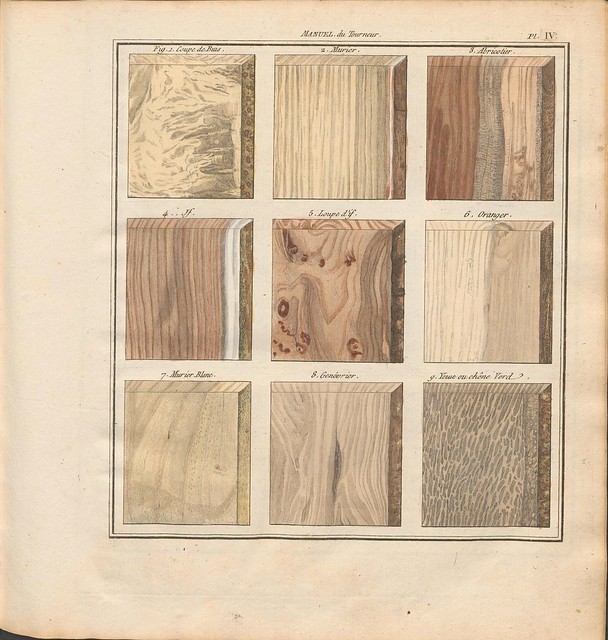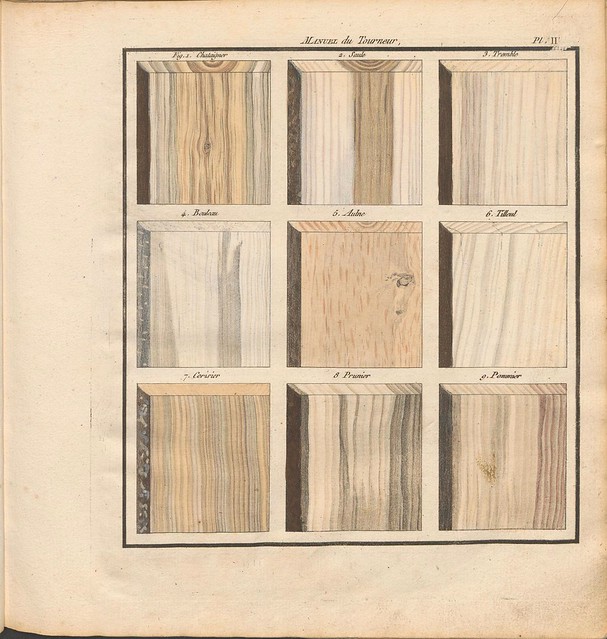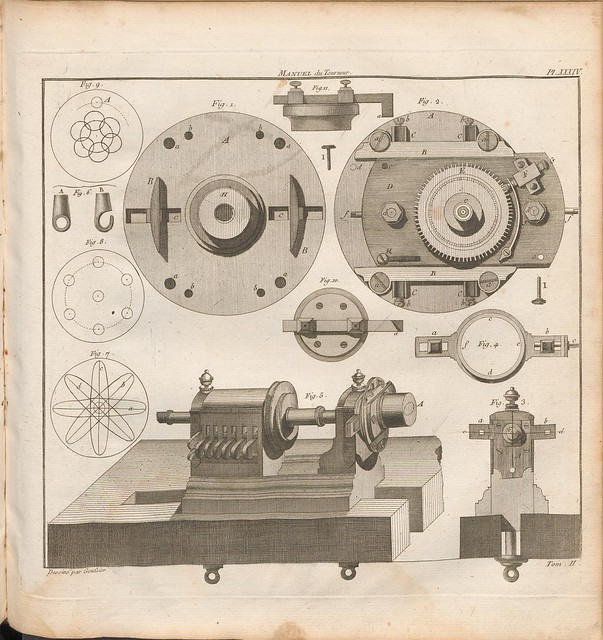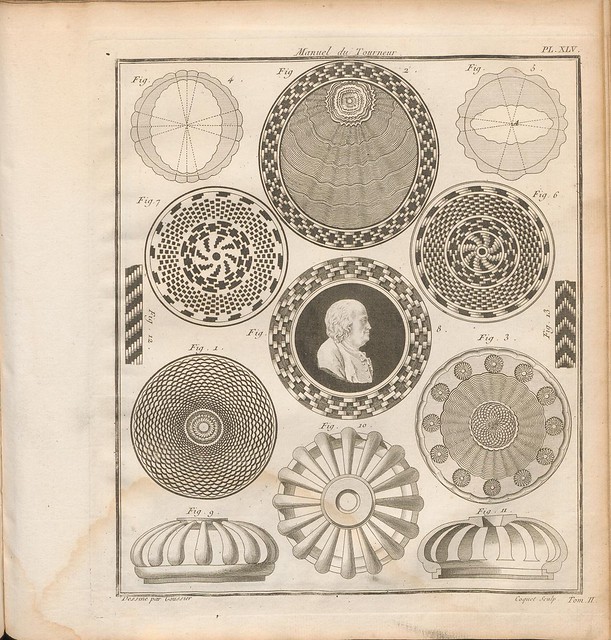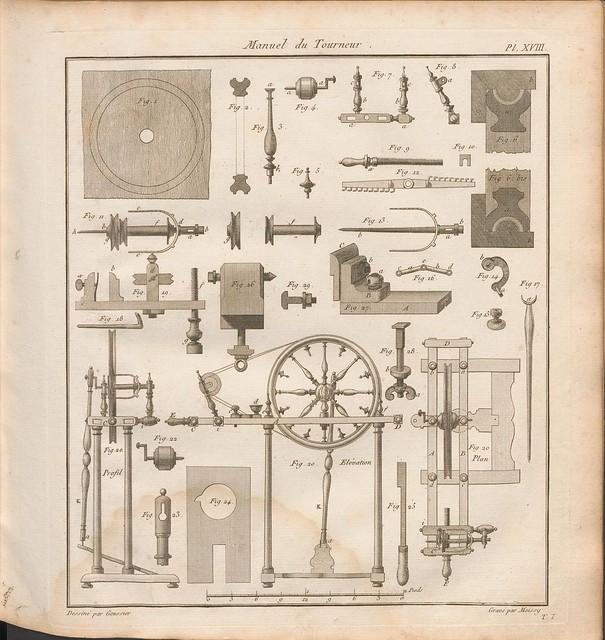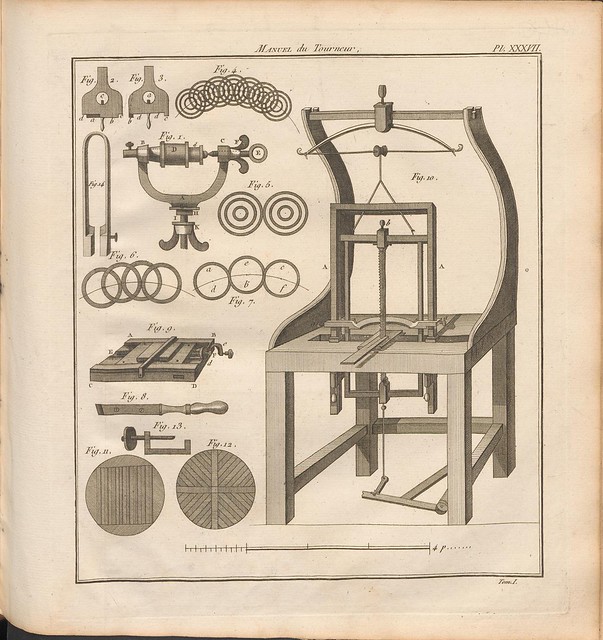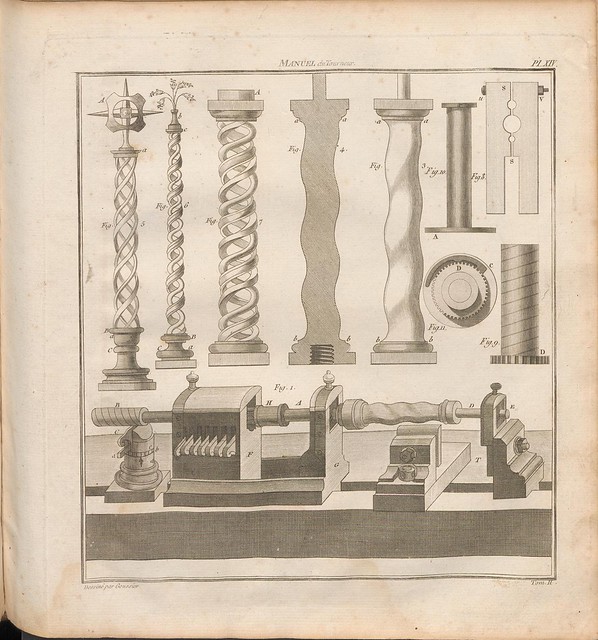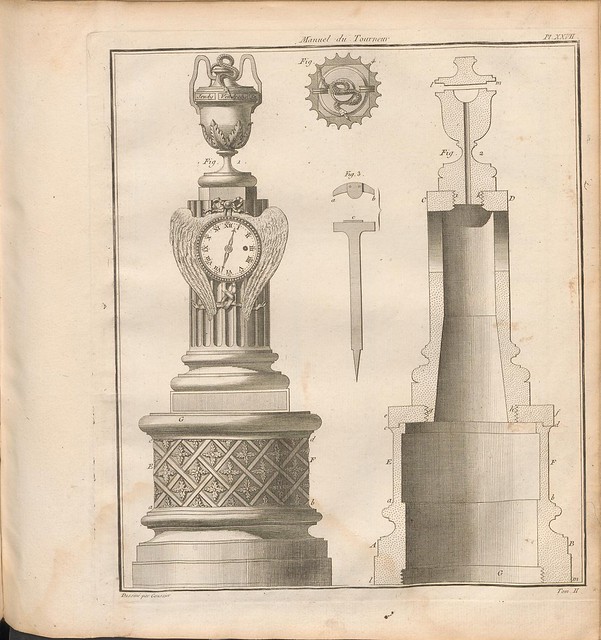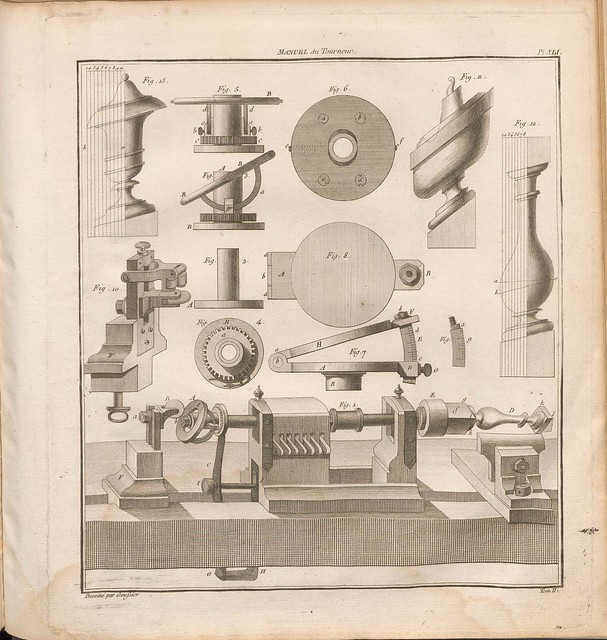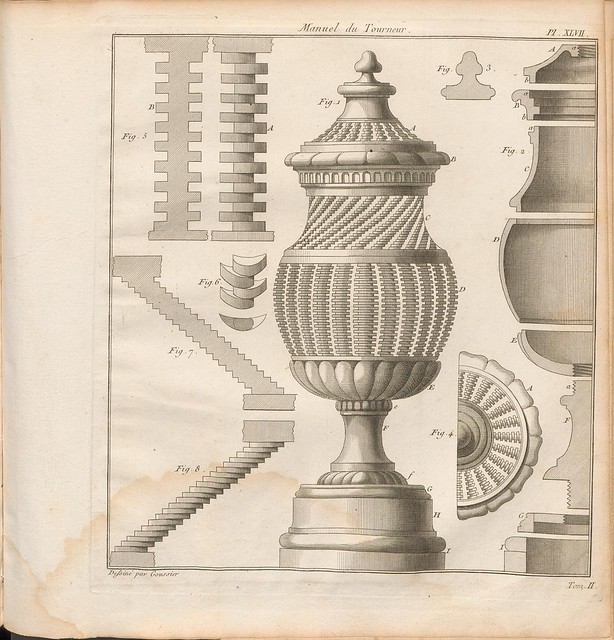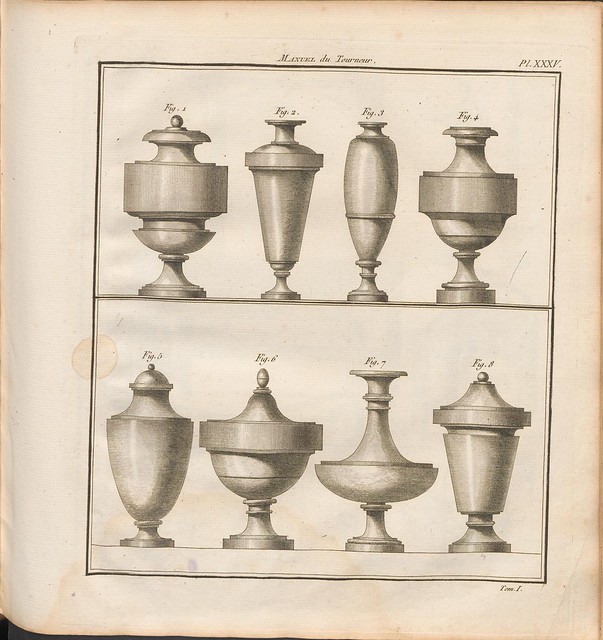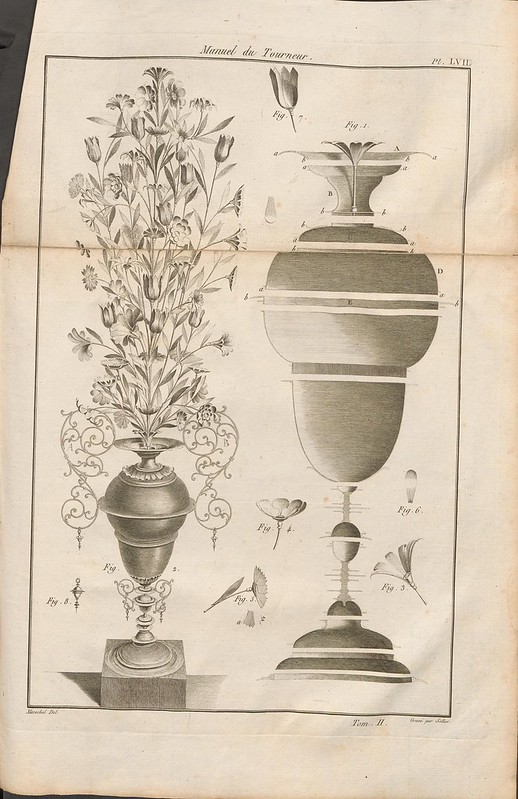"Chromatic type is printed from multiple pieces of type, each in a different ink color. The following samples are all from the William H. Page company's 1874 book, 'Specimens of Chromatic Wood Type, Borders, Etc.' [.]. The specimen book was used to sell the wooden pieces of type to printers. The types cost around 25 cents per letter, per ink color.
[In some images you can see] white lines between the [different colors or as part of the letter borders]. That's the paper showing through, and it's an intentional part of the design meant to add another color. Remember, each color is the result of the sheet of paper making a separate pass through the press.
Getting each piece of type to hit the sheet of paper in exactly the right spot relative to the other colored parts of the same letter required amazing craftsmanship. The system of controlling positioning is called registration. These chromatic types were designed to register as much as possible (they were cut from a single multi-level pattern), but given the inherent inexactness of the presses, it's still quite a feat." [source]
Rob Roy Kelly wrote that Wm. H. Page’s 'Specimens of Chromatic Wood Type, Borders, Etc.', 1874 “has been rightfully acclaimed as containing the most superb wood type specimens ever printed.” This tome of 100 plates featured Page’s fantastic character designs, intricate borders and tint blocks, precisely printed in up to 7 colors each — sometimes with metallic inks, and always with interesting overprinted hues. [source]
The images below from 'Specimens of Chromatic Wood Type..',
were sourced from Columbia University Libraries website.
![Specimens of chromatic wood type, borders 1874 - [via Columbia U] (Sin) Belgian ornamented No.2 type](http://farm8.staticflickr.com/7319/10296775494_c97ea3db92_c.jpg)
Belgian ornamented No.2 type
![Specimens of chromatic wood type, borders 1874 - [via Columbia U] (..Providence) Doric Florentine + Ornamented type](http://farm8.staticflickr.com/7318/10296783024_c56eeb03d4_c.jpg)
Doric, Florentine, Clarendon & Aldine Ornamented, Etruscan type
![Specimens of chromatic wood type, borders 1874 - [via Columbia U] (Rind + Use) - Gothic paneled No.2 type](http://farm6.staticflickr.com/5540/10296870226_5d0f910ab3_c.jpg)
Gothic paneled No.2 type
![Specimens of chromatic wood type, borders 1874 - [via Columbia U] (Wade's Ink printer's page)](http://farm8.staticflickr.com/7291/10296773744_cf04f972d4_c.jpg)
"To Color Printers
We have the pleasure of laying before you a Specimen Book of Chromatic Wood Type, and would say it is now eighteen years since we began Type making. Progress in the Art can be seen by comparing the present volume, with Specimens of that date. There were at that time five or six other manufacturers in the country. Now we manufacture seven-eights of all the Wood Type made, and are now able to show by itself a Book of Chromatic Type and Borders that is not excelled in the world. It has taken years of time to prepare and perfect it. The designs with two or three exceptions are entirely original with us. The demand for Chromatic Type is quite limited, therefore we cannot apply this book free, only to our Agents Most Respectfully Yours, Wm. H. Page & Co."
[Introduction to 'Specimens of Chromatic Wood Type' 1874]
![Specimens of chromatic wood type, borders 1874 - [via Columbia U] Rustic + Bride + Mun) Corinthian type](http://farm3.staticflickr.com/2841/10296772794_076a9d06da_c.jpg)
Corinthian type
![Specimens of chromatic wood type, borders 1874 - [via Columbia U] (Chromatic Double Star + background tints)](http://farm3.staticflickr.com/2888/10296875915_a107a93979_c.jpg)
![Specimens of chromatic wood type, borders 1874 - [via Columbia U] (Pink + Red) Ornamented type](http://farm6.staticflickr.com/5535/10296872755_56cd977f55_c.jpg)
Ornate type
![Specimens of chromatic wood type, borders 1874 - [via Columbia U] (Recount+ Humor + Rude) Streamer Gothic Paneled type](http://farm3.staticflickr.com/2818/10296872845_0e4a844d08_c.jpg)
Streamer Gothic Paneled type
![Specimens of chromatic wood type, borders 1874 - [via Columbia U] (I + E) Renaissance type](http://farm3.staticflickr.com/2851/10296877805_a86c0f2537_c.jpg)
Renaissance type
![Specimens of chromatic wood type, borders 1874 - [via Columbia U] (border cards)](http://farm8.staticflickr.com/7454/10296875416_e7d33e2b92_c.jpg)
![Specimens of chromatic wood type, borders 1874 - [via Columbia U] (..Mosaic) Etruscan type](http://farm6.staticflickr.com/5506/10296876326_b2b268f391_c.jpg)
Etruscan type
![Specimens of chromatic wood type, borders 1874 - [via Columbia U] (Storm + Shun + Bug) Clarendon ornamented](http://farm6.staticflickr.com/5494/10296774364_cbdaeda12a_c.jpg)
Clarendon ornamented type
![Specimens of chromatic wood type, borders 1874 - [via Columbia U] (M) French Clarendon ornamented type](http://farm3.staticflickr.com/2852/10296990543_4d0122b4d3_c.jpg)
French Clarendon ornamented type
"Specimens of Chromatic Wood Type, Borders, Etc., Manufactured by Wm. H. Page & Co. Greeneville, Ct.: The Co., 1874.
William H. Page (1829–1906), worked while young as a wood type finisher at manufacturer John Cooley’s shop. He later bought out another firm’s machinery and expanded by the 1860s to be the country’s chief producer of wood type. Intense competition through the mid-1880s with J. E. Hamilton’s cheaper veneered types sent Page’s market share into decline. He sold his business to the Hamilton Company in 1891.
Page’s firm had a great catalog of original character designs, intricate borders, and tint blocks cut with exacting precision. The company can be credited with printing possibly the most beautiful color wood type specimen ever, a page of which is on view here. Each plate in this book is letterpress printed with several colors, showing the versatility of color blends imaginable with Page products. The specimen of some 100 pages was produced in a small edition since the market for chromatic wood type was very limited." [source]
![Specimens of chromatic wood type, borders 1874 - [via Columbia U] Braids + Made +Gof) Old English ornamented type](http://farm6.staticflickr.com/5486/10296773864_8250eec793_c.jpg)
Old English ornamented type
![Specimens of chromatic wood type, borders 1874 - [via Columbia U] (Erudition + Bluster +Pines) Arcadian type](http://farm3.staticflickr.com/2819/10296874715_1a6e6f57dd_c.jpg)
Arcadian type
![Specimens of chromatic wood type, borders 1874 - [via Columbia U] (Detriment + Prison + Unite) Gothic ornamented type](http://farm8.staticflickr.com/7389/10296780464_5a37c8e6fc_c.jpg)
Gothic ornamented type
![Specimens of chromatic wood type, borders 1874 - [via Columbia U] (Mend + Mun) Streamer Arcadian + Arabian type](http://farm3.staticflickr.com/2872/10296778094_9cca14efa0_c.jpg)
Streamer Arcadian & Arabian type
![Specimens of chromatic wood type, borders 1874 - [via Columbia U] (stars + star borders)](http://farm4.staticflickr.com/3709/10296775564_3020d06e15_c.jpg)
Stars, cut any size desired
![Specimens of chromatic wood type, borders 1874 - [via Columbia U] (Kitchen + Round + Bits + Sin) Aetna ornamented type](http://farm8.staticflickr.com/7419/10296875035_6ba4edf5a7_c.jpg)
Aetna ornamented type
"Chromatic types were made to print in two or more colors. These types, produced in register as corresponding pairs, were designed so that one color would overlap another in certain places to create a third color. Chromatic types were shown regularly in foundry type specimen books of the 1840s and 1850s.
Chromatic types were first produced as wood type by Edwin Allen, and shown by George Nesbitt in his 1841 Fourth Specimen of Machinery Cut Wood Type. Both William H. Page in 1859, and J.G. Cooley in c.1859, showed several pages of Chromatic type in each of their wood type specimen books. Page showed these types in most of his specimen books in the 1870s. The high point of Chromatic wood type production came in 1874 when the William H. Page Wood Type Co. issued their 100-page Specimens of Chromatic Type & Borders. Though Hamilton, Morgans & Wilcox, and Heber Wells all showed samples of Chromatic types through the rest of the century, none of these ever reached the level of intricate precision attained in Page’s 1874 masterpiece." [source]
- The complete 'Specimens of Chromatic Wood Type, Borders etc Manufactured by Wm H Page & Co' 1874 is available online from Columbia University Libraries. That same copy is available in various formats through the Internet Archive.
- Wood type books at Amazon.
- Woodtyper - 'notes on large & ornamented type & related matters' - very much worth perusing despite being on apparent hiatus since 2010.
- The Hamilton Wood Type Museum "is the only museum dedicated to the preservation, study, production and printing of wood type. With 1.5 million pieces of wood type and more than 1,000 styles and sizes of patterns, Hamilton's collection is one of the premier wood type collections in the world." (@hamiltonwoodtyp) {Two Rivers, Wisconsin}.
- *Chromatic Wood Type Goes Colorimetric at RIT* Oct 2013 by Amelia Hugill-Fontanel of RIT Cary Graphic Arts. [nb. printinghistory will soon have a .org suffix]
- The Rob Roy Kelly American Wood Type Collection at the University of Austin, Texas.
- The Collected Writings of Rob Roy Kelly at the Rochester Institute of Technology, New York.
- From the Exhibitions site at RIT's Cary Graphic Arts Collection, the Wood Type Exhibition - a good intro/overview of the craft.
- Wood type category entries from Typography.com.
- 'Chromatic Type' blog post from 2010.
- 'Intercut wood typeface project' by Nick Sherman [@NickSherman]
- ADDIT: Nick recently gave a talk on the 'Specimens of Wood Type..' book at an American Printing History Association conference - it looks to have been a fabulous line up, ostensibly covering colour in illustrated prints, books, comics and letterpress to digital printing & more, through 500+ years of human printing history.
- 'Polychromatic Digital Type - Over the Rainbow' by GF Aug 2013 advises [for good or ill] that a budding new standard, supported by Microsoft, "will allow true, infinitely resizeable multicoloured type on the internet, in apps and even for home colour printers".
- Thanks very much to Nina & Jesse.
- I purposefully arranged for SIN to be at the beginning and end of the visuals, not just because it's an arresting word, but because I associate a lot of this lettering with 19th century American saloon signage: I must have seen too many westerns as a kid.
- This post first appeared on the BibliOdyssey website.
